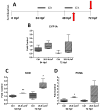Induction of cytochrome P450 1 genes and stress response genes in developing zebrafish exposed to ultraviolet radiation
- PMID: 20189255
- PMCID: PMC2864789
- DOI: 10.1016/j.aquatox.2010.01.008
Induction of cytochrome P450 1 genes and stress response genes in developing zebrafish exposed to ultraviolet radiation
Abstract
Ultraviolet (UV) radiation damages cell molecules, and has been suggested to up-regulate mammalian cytochrome P4501 (CYP1) genes through an aryl hydrocarbon receptor (AHR) mediated mechanism. In this study, embryos and larvae of zebrafish (Danio rerio) were exposed to UV to determine the effects on expression of CYP1 and stress response genes in vivo in these fish. Zebrafish embryos were exposed for varying times to UV on two consecutive days, with exposure beginning at 24 and 48h post-fertilization (hpf). Embryos exposed for 2, 4 or 6h twice over 2 days to UVB (0.62 W/m(2); 8.9-26.7 kJ/m(2)) plus UVA (2.05 W/m(2); 29.5-144.6 kJ/m(2)) had moderately (2.4+/-0.8-fold) but significantly up-regulated levels of CYP1A. UVA alone had no effect on CYP1A expression. Proliferating cellular nuclear antigen (PCNA) and Cu-Zn superoxide dismutase (SOD1) transcript levels were induced (2.1+/-0.2 and 2.3+/-0.5-fold, respectively) in embryos exposed to two 6-h pulses of 0.62 W/m(2) UVB (26.8 kJ/m(2)). CYP1A was induced also in embryos exposed to higher intensity UVB (0.93 W/m(2)) for two 3-h or two 4-h pulses (20.1 or 26.8 kJ/m(2)). CYP1B1, SOD1 and PCNA expression was induced by the two 3-h pulses of the higher intensity UVB, but not after two 4-h pulses of the higher intensity UVB, possibly due to impaired condition of surviving embryos, reflected in a mortality of 34% at that UVB dose. A single 8-h long exposure of zebrafish larvae (8dpf) to UVB at 0.93 W/m(2) (26.8 kJ/m(2)) significantly induced CYP1A and CYP1B1 expression, but other CYP1 genes (CYP1C1, CYP1C2 and CYP1D1) showed no significant increase. The results show that UVB can induce expression of CYP1 genes as well stress response genes in developing zebrafish, and that UVB intensity and duration influence the responses.
Copyright (c) 2010 Elsevier B.V. All rights reserved.
Figures




Similar articles
-
Role of AHR2 in the expression of novel cytochrome P450 1 family genes, cell cycle genes, and morphological defects in developing zebra fish exposed to 3,3',4,4',5-pentachlorobiphenyl or 2,3,7,8-tetrachlorodibenzo-p-dioxin.Toxicol Sci. 2007 Nov;100(1):180-93. doi: 10.1093/toxsci/kfm207. Epub 2007 Aug 8. Toxicol Sci. 2007. PMID: 17686920
-
Basal and 3,3',4,4',5-pentachlorobiphenyl-induced expression of cytochrome P450 1A, 1B and 1C genes in zebrafish.Toxicol Appl Pharmacol. 2007 May 15;221(1):29-41. doi: 10.1016/j.taap.2007.02.017. Epub 2007 Mar 12. Toxicol Appl Pharmacol. 2007. PMID: 17445853 Free PMC article.
-
The tryptophan photoproduct 6-formylindolo[3,2-b]carbazole (FICZ) binds multiple AHRs and induces multiple CYP1 genes via AHR2 in zebrafish.Chem Biol Interact. 2009 Oct 30;181(3):447-54. doi: 10.1016/j.cbi.2009.07.003. Epub 2009 Jul 15. Chem Biol Interact. 2009. PMID: 19615353 Free PMC article.
-
New CYP1 genes in the frog Xenopus (Silurana) tropicalis: induction patterns and effects of AHR agonists during development.Toxicol Appl Pharmacol. 2011 Jan 15;250(2):170-83. doi: 10.1016/j.taap.2010.10.010. Epub 2010 Oct 18. Toxicol Appl Pharmacol. 2011. PMID: 20965207 Free PMC article.
-
Differential tissue distribution, developmental programming, estrogen regulation and promoter characteristics of cyp19 genes in teleost fish.J Steroid Biochem Mol Biol. 2001 Dec;79(1-5):305-14. doi: 10.1016/s0960-0760(01)00147-9. J Steroid Biochem Mol Biol. 2001. PMID: 11850237 Review.
Cited by
-
Responses to ROS inducer agents in zebrafish cell line: differences between copper and UV-B radiation.Fish Physiol Biochem. 2014 Dec;40(6):1817-25. doi: 10.1007/s10695-014-9970-3. Epub 2014 Aug 15. Fish Physiol Biochem. 2014. PMID: 25119852
-
Summary of information on the effects of ionizing and non-ionizing radiation on cytochrome P450 and other drug metabolizing enzymes and transporters.Curr Drug Metab. 2012 Jul;13(6):787-814. doi: 10.2174/138920012800840356. Curr Drug Metab. 2012. PMID: 22571481 Free PMC article. Review.
-
Phenotypic and genotypic characterization of antioxidant enzyme system in human population exposed to radiation from mobile towers.Mol Cell Biochem. 2018 Mar;440(1-2):1-9. doi: 10.1007/s11010-017-3150-6. Epub 2017 Aug 17. Mol Cell Biochem. 2018. PMID: 28819931 Clinical Trial.
-
Mechanistic Investigations Into the Developmental Toxicity of Nitrated and Heterocyclic PAHs.Toxicol Sci. 2017 May 1;157(1):246-259. doi: 10.1093/toxsci/kfx035. Toxicol Sci. 2017. PMID: 28186253 Free PMC article.
-
CYP1B1 as a therapeutic target in cardio-oncology.Clin Sci (Lond). 2020 Nov 13;134(21):2897-2927. doi: 10.1042/CS20200310. Clin Sci (Lond). 2020. PMID: 33185690 Free PMC article.
References
-
- (NCAR/ACD) National Center for Atmospheric Research. NCAR/ACD TUV: Tropospheric Ultraviolet & Visible Radiation Model 2009
-
- Bittinger MA, Nguyen LP, Bradfield CA. Aspartate aminotransferase generates proagonists of the aryl hydrocarbon receptor. Mol Pharmacol. 2003;64:550–6. - PubMed
-
- Brash DE. Sunlight and the onset of skin cancer. Trends Genet. 1997;13:410–4. - PubMed
Publication types
MeSH terms
Substances
Grants and funding
LinkOut - more resources
Full Text Sources
Molecular Biology Databases
Miscellaneous

